18.04.2025
China rolls out rocket for Shenzhou 20 astronaut launch to its Tiangong space station
The next set of three astronauts is expected to lift off in the coming days.
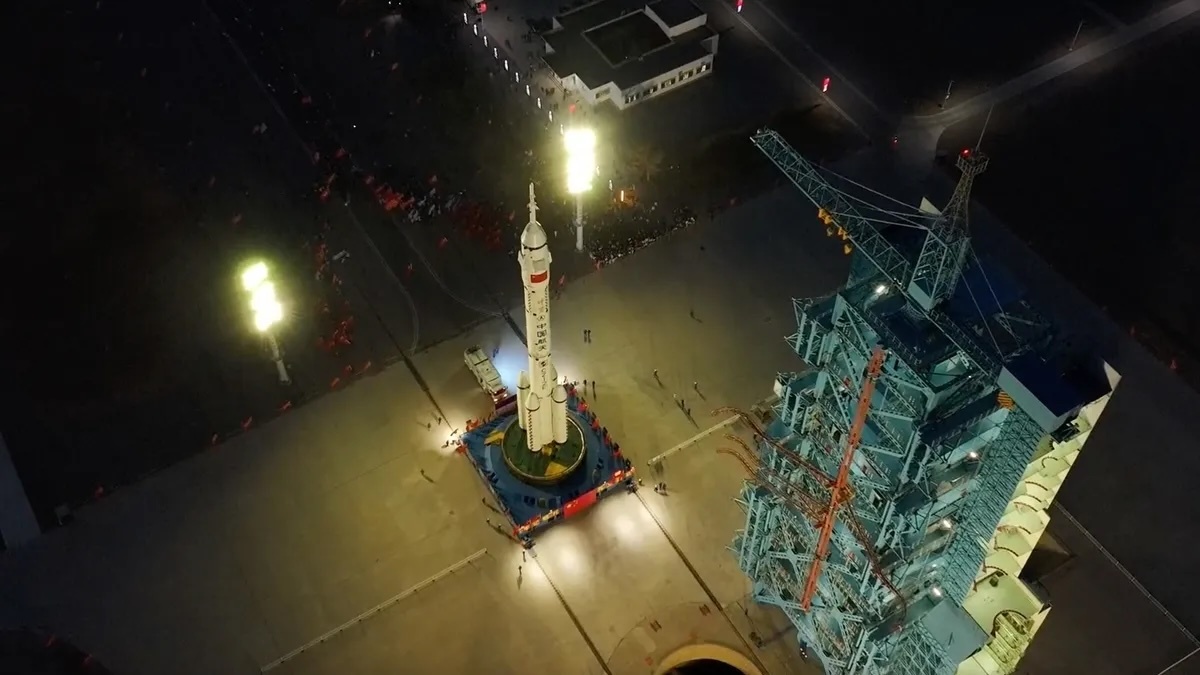
China is gearing up to launch its latest astronaut crew into orbit.
A Long March 2F rocket, topped with the Shenzhou 20 crew spacecraft, was rolled out to its launch pad at Jiuquan Satellite Launch Center on Wednesday (April 16), according to Chinese state media.
The 203-foot-long (62 meters) rocket was transferred vertically by rail, taking it 0.93 miles (1.5 kilometers) from the integration building to the pad, over the course of around two hours.
The rocket-spacecraft combo will now go through final checks and tests in preparation for launch, which will send three astronauts to the nation's Tiangong space station.
China has not stated when the mission will launch, instead stating that the spacecraft is set to be launched at an appropriate time in the coming days.
The identity of the three-person Shenzhou 20 crew, who will spend around six months aboard the Tiangong space station, also remains a secret. The crew are typically revealed a day ahead of launch at a pre-launch press conference at Jiuquan. Livestreams of the launch will be announced closer to liftoff.
Meanwhile, in orbit, the Shenzhou 19 crew — commander Cai Xuzhe, Song Lingdong and Wang Haoze — are wrapping up activities as their own six-month stay aboard Tiangong draws to a close.
The Shenzhou 19 trio arrived at Tiangong in late October 2024. Their work has included three spacewalks — including a record-breaking excursion outside of the space station, and conducting a sweeping range of experiments.
China completed its three-module Tiangong in late 2022. The station has been constantly occupied ever since. The country has also announced that it will train astronauts from Pakistan ahead of a short-term mission to Tiangong in the coming years.
Quelle: SC
----
Update: 23.04.2025
.
China announces new life science experiment program in space station
The new life science experiments to be conducted in China's space station during the Shenzhou-20 crewed spaceflight mission will involve zebra fish, planarians and Streptomyces, the China Manned Space Agency (CMSA) announced on Wednesday.
Notably, the Shenzhou-20 mission marks China's first space-based investigation into the regeneration of planarians, a new organism introduced to China's space station and known for their extraordinary ability to regrow organs, CMSA spokesman Lin Xiqiang said at a press conference on the Shenzhou-20 crewed spaceflight mission.
"This project will enhance our understanding of fundamental mechanisms of regeneration at the individual level and could provide insights into human health issues related to space-induced injuries," said Lin.
Noting that previous experiments with zebra fish and fruit flies in space were highly successful, Lin said that the Shenzhou-20 mission will further experiment based on the zebra fish-hornwort co-cultivation ecosystem established during the Shenzhou-18 mission.
The new zebra fish experiment will focus on protein homeostasis in higher vertebrates under microgravity and seeks to clarify how protein homeostasis regulates bone mass decrease and cardiovascular dysfunction caused by microgravity, he said.
As for Streptomyces, which can serve as critical players in soil health and plant resilience, the related experiment will study the expression patterns of microbial active substances and enzymes in space environments to lay the foundation for developing microbial technologies and products utilizing space resources, he added.
In addition, the Shenzhou-20 crew will conduct another 59 experiments spanning space life sciences, microgravity physics, and new space technologies, according to the spokesman.
Breakthroughs are expected to be made in areas such as the cultivation of chips for vascularized brain organoids, non-equilibrium dynamics of soft matter, and the space-based preparation of high-temperature superconducting materials, he noted.
China's space station has now hosted over 200 scientific projects, with nearly 2 tonnes of scientific materials and applied equipment sent to orbit and nearly 100 experimental samples returned to Earth.
"Currently, we are conducting space science experiments according to plan, with all projects progressing smoothly," said Lin.
He added that the scientific results will be released regularly, following the first report on China's space station science and application progress in December last year.
The Shenzhou-20 crewed spaceship is scheduled to be launched at 5:17 p.m. Thursday (Beijing Time) from the Jiuquan Satellite Launch Center in northwest China.
Quelle: Xinhua
+++
China unveils Shenzhou-20 crew for space station mission
Chinese astronauts Chen Dong, Chen Zhongrui and Wang Jie will carry out the Shenzhou-20 crewed spaceflight mission, and Chen Dong will be the commander, the China Manned Space Agency announced at a press conference on Wednesday.
The Shenzhou-20 crewed spaceship is scheduled to be launched at 5:17 p.m. Thursday (Beijing Time) from the Jiuquan Satellite Launch Center in northwest China, said Lin Xiqiang, spokesperson of the agency.
Chen Dong participated in the Shenzhou-11 and Shenzhou-14 space missions. He served as the commander of the Shenzhou-14 crew and will take on the mantle once again after a two-year interval. He will also become the first among China's second batch of astronauts to carry out three spaceflight missions.
Chen Zhongrui and Wang Jie both come from the third batch of astronauts and will embark on their first spaceflight mission. Before being selected, Chen Zhongrui was an air force pilot, while Wang Jie was an engineer at the China Academy of Space Technology under the China Aerospace Science and Technology Corporation.
Chen Dong described his crew as embodying a synergy of precision and rigor. Speaking to the press on Wednesday, he said the pilot brings sharp thinking and precise operational skills, while the engineer contributes a meticulous attitude and a solid theoretical foundation.
"I have full confidence in our team, and it is capable and resourceful. We collaborate effectively, with each member fulfilling their role and handling responsibilities independently," he added.
The Shenzhou-20 astronauts will complete in-orbit rotation with the Shenzhou-19 crew and stay at the space station for approximately six months, according to Lin.
The new crew will undertake a range of tasks, including space science experiments, application tests, extravehicular activities, and cargo handling. Their mission also involves installing protective devices against space debris, deploying and retrieving extravehicular payloads and equipment. They will also participate in science education, public outreach, and other onboard experimental activities.
The Shenzhou-19 astronauts are scheduled to return to the Dongfeng landing site in north China's Inner Mongolia Autonomous Region on April 29, Lin said.
Quelle: Xinhua
+++
China completes 20 astronaut extravehicular activities
China has successfully carried out 20 astronaut extravehicular activities (EVAs) over the course of its space program, with its EVA technology among the most advanced worldwide, a spokesperson with the China Manned Space Agency said on Wednesday.
The longest single EVA by Chinese astronauts reached nine hours, setting a world record, said CMSA spokesperson Lin Xiqiang at a press conference on the Shenzhou-20 crewed spaceflight mission.
The extravehicular spacesuits, Feitian, meaning flying into space, have maintained good performance and stable conditions in EVAs since the Shenzhou-12 mission. The highest usage of a single spacesuit has reached 17 times, according to the spokesperson.
The space station's robotic arms, which can be connected and "crawl" on the exterior of the space cabins due to their unique designs, enable astronauts to access all EVA areas.
Additionally, the coordination support system between space and ground has been refined to provide robust professional backing for EVA planning, real-time control, cross-system collaboration, and emergency response.
The EVAs help verify key technologies concerning extravehicular spacesuits, airlock cabins, robotic arm-assisted operations, and coordination support between space and ground, Lin said.
The activities include the installation of an expansion pump set, payload exposure platform support rods, panoramic camera brackets, as well as the connection of cross-module cables, fulfilling the space station's full functional design.
Following damage to the solar wing cables of the Tianhe core module caused by space debris impacts, astronauts carried out China's first extravehicular maintenance via two EVAs. They successfully eliminated the impact on the solar arrays and restored the power supply.
To ensure the space station's long-term reliability amid growing debris threats, China transitioned from reactive repairs to active prevention, conducted multiple EVAs for inspections, and installed space debris shielding devices, significantly enhancing orbital defense capabilities of the space station.
China's EVAs have evolved from technical verification and basic operations to complex mission execution, and will play an increasingly vital role in the long-term operation of the space station, Lin concluded.
Quelle: Xinhua
+++
China to launch Shenzhou-20 crewed spaceship on April 24
The Shenzhou-20 crewed spaceship is scheduled to be launched at 5:17 p.m. Thursday (Beijing Time) from the Jiuquan Satellite Launch Center in northwest China, the China Manned Space Agency (CMSA) said on Wednesday.
The spaceship will carry three astronauts, Chen Dong, Chen Zhongrui and Wang Jie, who will conduct the Shenzhou-20 spaceflight mission, with Chen Dong serving as the commander, CMSA spokesman Lin Xiqiang stated at a press conference.
He also noted that the launch day coincides with China's 10th Space Day.
China designated April 24 as its Space Day in 2016 to mark the successful launch of its first satellite, Dongfanghong-1, on April 24, 1970.
Thursday's launch will use a Long March-2F carrier rocket, which will be filled with propellant soon, Lin revealed, while adding that all preparation work is progressing smoothly.
Shenzhou-20 is the 35th flight mission of China's manned space program, and the fifth crewed mission during the application and development stage of China's space station.
After entering orbit, the Shenzhou-20 spaceship will require about 6.5 hours to perform its automated rendezvous and docking with the radial port of the space station core module Tianhe, thereby forming a combination of three modules and three spacecraft, Lin said.
During their 6-month stay in orbit, the Shenzhou-20 crew members will witness the arrivals of both the Tianzhou-9 cargo craft and their successors in the Shenzhou-21 crewed spaceship.
"The crew members are in good condition, while the rocket, spaceship and ground system facilities are all in stable operation, and the orbiting space station complex is working normally," Lin said. He added that all task teams are ready for the upcoming launch.
The trio is scheduled to return to the Dongfeng landing site in north China in late October this year, Lin said.
Quelle: Xinhua
+++
Astronauts of China's Shenzhou-20 mission meet press
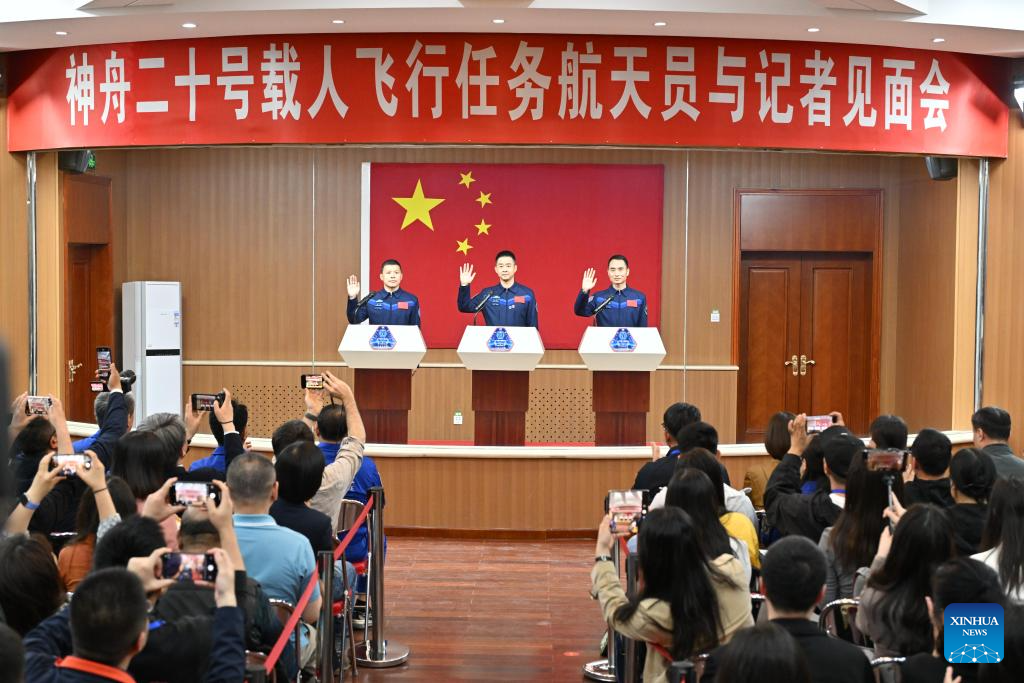
Astronauts for the upcoming Shenzhou-20 spaceflight mission Chen Dong (C), Chen Zhongrui (R) and Wang Jie meet the press in Jiuquan Satellite Launch Center in northwest China on April 23, 2025. (Xinhua/Li Xin)
Chen Dong, Chen Zhongrui and Wang Jie, the three Chinese astronauts for the upcoming Shenzhou-20 spaceflight mission, met the press on Wednesday.
The Shenzhou-20 crewed spaceship is scheduled to be launched at 5:17 p.m. Thursday (Beijing Time) from the Jiuquan Satellite Launch Center in northwest China, the China Manned Space Agency announced at a press conference earlier in the day.
Quelle: Xinhua
----
Update: 24.04.2025
.
Send-off ceremony held for Chinese astronauts of Shenzhou-20 mission
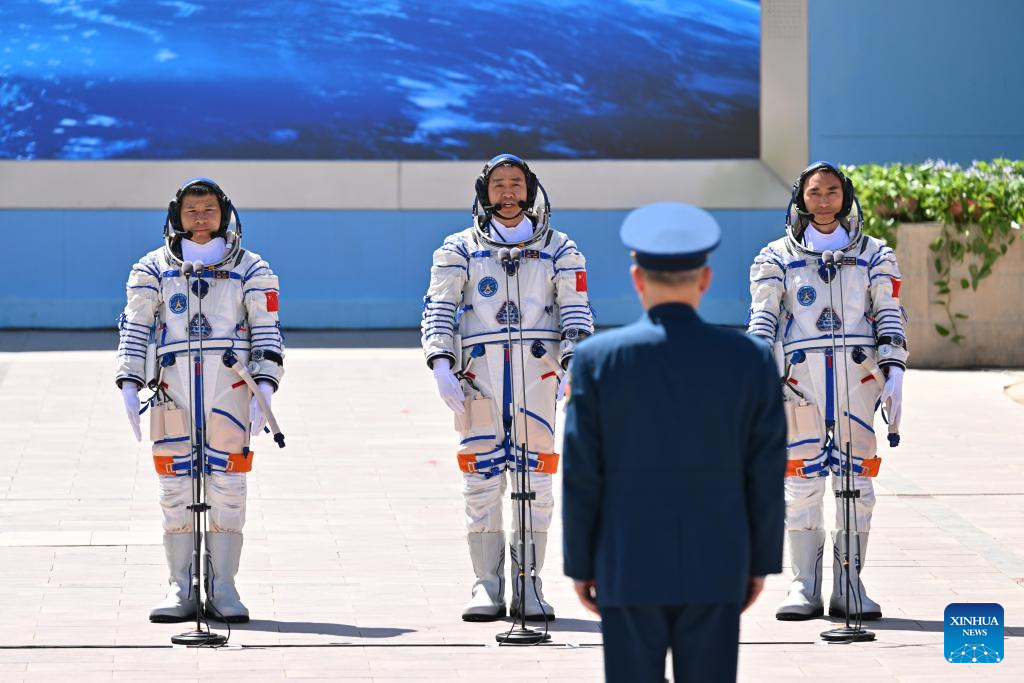
Chinese astronauts Chen Dong (C), Chen Zhongrui (R) and Wang Jie attend a send-off ceremony at the Jiuquan Satellite Launch Center in northwest China on April 24, 2025.
A send-off ceremony for the three Chinese astronauts of the Shenzhou-20 crewed space mission was held here on Thursday, according to the China Manned Space Agency. (Xinhua/Li Xin)
Quelle: Xinhua
----
Update: 25.04.2025
.
China launches Shenzhou 20 astronauts to Tiangong space station
The Shenzhou 20 spacecraft blasted off at 5:17 a.m. ET on Thursday (April 24).
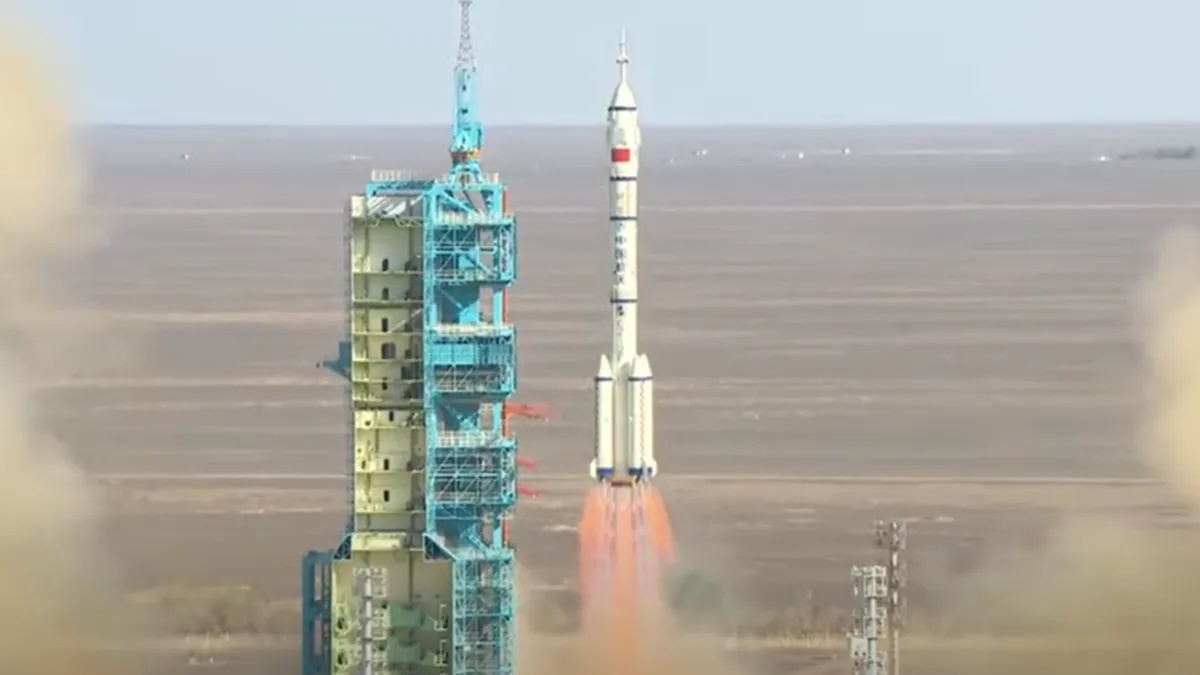
China's latest human spaceflight mission headed for orbit on Thursday morning (April 24).
A Long March 2F rocket topped with the Shenzhou 20 crew spacecraft lifted off from the Jiuquan Satellite Launch Center in northwest China on April 24 at 5:17 a.m. EDT (0917 GMT; 5:17 p.m. Beijing time).
Shenzhou 20 carried commander Chen Dong, on his third trip to space, and rookie astronauts Chen Zhongrui and Wang Jie, both of whom were selected for China's third intake of astronauts in 2020.
The Shenzhou 20 spacecraft is scheduled to rendezvous and dock at the Tiangong space station around 6.5 hours after launch. There, they will be greeted by the incumbent Shenzhou 19 crew, led by commander Cai Xuzhe. Cai and his two colleagues will hand over control of Tiangong to the incoming Shenzhou 20 astronauts, who will begin their six-month-long mission aboard the space station.
The Shenzhou 19 astronauts will then depart for Earth in their own spacecraft. The return is scheduled for April 29, according to airspace closure notices.
Chen Dong has strong spaceflight experience, having flown on the two-person Shenzhou 11 mission to the Tiangong 2 space lab—a smaller precursor to Tiangong—in 206. He then led the Shenzhou 14 mission to Tiangong in 2022, which oversaw the arrival of the two experiment modules to complete the three-module space station.
"On one hand, I feel immense pride and honor to once again embark on a space journey for my country. It is a great privilege and joy," Chen said during an April 23 press conference. "On the other hand, I have greater expectations. Every spaceflight is unique, and I look forward to gaining more experience and making new breakthroughs during this mission."
Chen Zhongrui was formerly a pilot in the People's Liberation Army Air Force (also referred to as the Chinese Air Force) while Wang was an aerospace engineer with China's main space contractor, CASC.
To become a qualified astronaut, Chen said he underwent intense training, covering over 200 subjects across eight categories, while also facing challenges such as centrifuge training and spin-chair exercises. He was inspired by a visit to his University by Yang Liwei, China's first astronaut in space. "At the time, I never dared to imagine that years later, I would become an astronaut myself," he said.
Wang stated that he will, as a spaceflight engineer, be assisting the other two astronauts and will mainly be responsible for materials management as part of the mission's science objectives.
"We are ready, and we are looking forward to going to space," Wang said. "This time, the responsibility has been placed on our shoulders. I think it is a sense of duty. We hope to do our job well, manage the space station effectively, and successfully complete our experimental projects during the six months in space."
China will launch the Tianzhou 9 cargo resupply mission to Tiangong during the Shenzhou 20 astronauts' time aboard the space station, delivering fresh supplies, propellant for maintaining Tiangong's orbit, and new experiments and materials.
Shenzhou 20 is the ninth crewed mission headed for Tiangong — which orbits between 217 and 280 miles (340 to 450 kilometers) above Earth — and will be the sixth visit since the three-module orbital outpost was fully assembled in October 2022. Shenzhou 20 will be the fifth mission of what China Manned Space Agency (CMSA) terms the application and development stage of China's space station.
China plans to keep Tiangong, which is about 20% as massive as the International Space Station (ISS), permanently inhabited for at least a decade. The country also wants to expand the space station with new modules and open the outpost to commercial activities.
CMSA and Pakistan are currently working together in preparation for the first foreign astronaut to fly to Tiangong.
Quelle: SC
+++
Shenzhou-20 astronauts enter space station
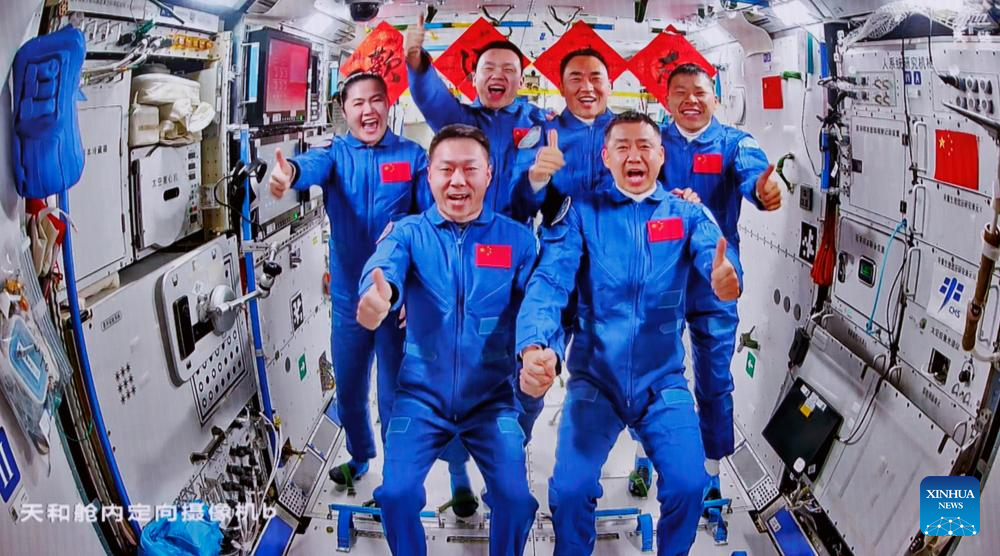
This image captured at Beijing Aerospace Control Center on April 25, 2025 shows a group photo of the crew of Shenzhou-19 and Shenzhou-20 manned spaceships. The three astronauts aboard China's Shenzhou-20 spaceship have entered the country's space station and met with another astronaut trio in the early hours of Friday, starting a new round of in-orbit crew handover. (Xinhua/Jin Liwang)
The three astronauts aboard China's Shenzhou-20 spaceship have entered the country's space station and met with another astronaut trio in the early hours of Friday, starting a new round of in-orbit crew handover.
The Shenzhou-19 crew opened the hatch at 1:17 a.m. (Beijing Time) and greeted the new arrivals, according to the China Manned Space Agency (CMSA).
The six crew members then took group pictures for the sixth space get-together in China's aerospace history.
They will live and work together for about five days to complete planned tasks and handover work, the CMSA said.
The Shenzhou-19 crew is scheduled to return to the Dongfeng landing site in north China's Inner Mongolia Autonomous Region on April 29. ■

This image captured at Beijing Aerospace Control Center on April 25, 2025 shows the crew of Shenzhou-19 and Shenzhou-20 manned spaceships talking with each other. The three astronauts aboard China's Shenzhou-20 spaceship have entered the country's space station and met with another astronaut trio in the early hours of Friday, starting a new round of in-orbit crew handover. (Xinhua/Jin Liwang)
Quelle: Xinhua
